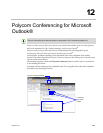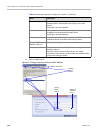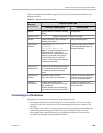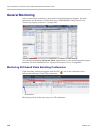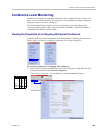
Polycom RealPresence Collaboration Server (RMX) 1500/2000/4000
12-6 Polycom, Inc.
a Define the following fields:
b Click the OK button.
If applicable, RSS, VMC, DMA and calendaring-enabled endpoints are configured with
the Exchange Server Name, User Names and Passwords needed to access their accounts.
For more information see the Polycom Unified Communications Deployment Guide for
Microsoft Environments.
2 The administrator configures the RMX to have a default Ad-hoc Entry Queue service
enabled. If ISDN/PSTN participants are included, up to two ISDN/PSTN dial-in
numbers must be configured for the Ad Hoc Entry Queue.
For more information see "Defining a New Entry Queue” on page 7-3.
Calendaring Guidelines
• The RMX must have its MCU prefix registered in the gatekeeper.
For more information see "Modifying the Default IP Network Service” on page 16-11.
• The RMX must be configured as a Static Route.
For more information see "Modifying the Default IP Network Service” on page 16-11.
•The RMX’s Default Entry Queue must be configured as an Ad Hoc Entry Queue and must
be designated as the Transit Entry Queue.
For more information see the "Entry Queues” on page 7-1.
Table 12-3 Exchange Integration Configuration - Option 3
Field Description
Exchange Server
Address
If Exchange Server settings have been modified, enter the full
path to the Microsoft Exchange Server where the RMX’s
Microsoft Outlook e-mail account is registered, for example if the
EWS folder has been renamed EWD:
https://labexch01/EWD/Exchange.asmx
Note: If a server name is entered, the RMX and the Microsoft
Exchange Server must be registered to the same Domain. (The
Domain name entered in this dialog box must match the Local
Domain Name entry in the Management Network - DNS
Properties dialog box.)
For more information see "Modifying the Management Network”
on page 16-3.
Field length: Up to 80 characters.
Enable Calendaring
Service
These fields are defined as for Option 1 above.
User Name
Password
Domain
Primary SMTP
Mailbox (Optional)
Accept Appointments






